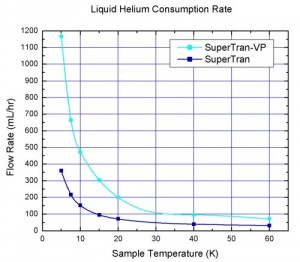LHe Cryostat
LIQUID HELIUM AND LIQUID NITROGEN
SuperTran Continuous Flow Cryostat Systems – Sample in Vacuum
With an extensive range of field-proven applications and a worldwide installation base, Janis Research SuperTrans represent the state-of-the-art in continuous flow cryostat design. Utilizing liquid helium (LHe) or liquid nitrogen (LN2), most of the systems provide fast (15 minutes or less to 4.2 K with LHe) cooldown, a <2 K -325 K total operating range and precise temperature control capability in an economical and easy-to-use package.

All systems consist of a cold finger, radiation shield, sample holder, lightweight aluminum vacuum shroud, electrical feedthrough ports and a high efficiency flexible six foot cryogen transfer line. SuperTrans can be operated in any orientation with only minor variations in efficiencies. Temperatures of the sample is varied by means of a heater attached to the cold finger. The sample mount and all standard Janis sample holders have provisions for thermometry which, in conjunction with an optional temperature controller, allow precise control over sample temperature.
Standard systems produce sample temperatures of 77-325 K (LN2) and 4.2-325 K (LHe). Continuous operation at temperatures below 4.2 K is readily achieved by reducing the pressure at the venting port of the system. For most of the systems,
A high efficiency superinsulated, vacuum- jacketed transfer line, equipped with evacuation and safety pressure relief valves, connects the cryostat head to a storage dewar. The 0.50 inch diameter storage dewar leg fits most commercially available storage dewars. All Janis Research systems are fully integrated and liquid helium tested at our Wilmington, Massachusetts facility prior to shipment.
SPECIAL FEATURES AND BENEFITS
- No vacuum pump required for temperatures over 4.2 K
- No heating of exhaust gas required
- Monitoring of flow rate not required
- Easily adaptable to a He recovery system
- Highly flexible transfer line with a minimum 12″ bend radius
BASIC SYSTEM SPECIFICATIONS – CONTINUOUS FLOW CRYOSTATS

TYPICAL CRYOGEN CONSUMPTION OF OPTICAL SUPERTRAN CRYOSTATS

ST-100 CRYOSTAT SYSTEMS
Optical continuous flow cryostat suitable for a wide range of applications: the window material and geometry can be specified to allow spectroscopy with excitation energies from gamma rays through to the far infrared.
ST-100-FTIR CRYOSTAT SYSTEMS
Optical continuous flow cryostat suitable for FTIR applications. These cryostats are similar to our standard model ST-100cryostats, but with the ability to manipulate between samples.
ST-170 ESR CRYOSTAT SYSTEMS
Specifically designed for magnetic resonance applications, the ST-170 cryostat is the ideal choice for ESR spectroscopy. Using the same high efficiency transfer lineas the other SuperTran cryostats, the ST-170 features low helium consumption and fast cool down. The cryostat will easily fit between the poles of a magnet.
ST-200 TUBULAR SYSTEMS
Cryostats with tubular tails suitable for resistivity measurements or experimental configurations where square tails are undesirable.
ST-200-NMR Tubular Systems
Similar to the standard ST-200Tubular System, but custom designed for NMR Spectroscopy.
ST-300/300T COMPACT SYSTEMS
Designed for experiments with limited space, these cryostats are available in optical or non-optical configurations. The tail diameters can be specified to fit your experiment.
ST-300-MS COMPACT SYSTEM FOR MICROSCOPY
Designed as an alternative to the ST-500microscope cryostat, this compact cryostat combines short working distance with the standard SuperTran design. The ST-300-MS cryostat is intended for use in experiments with very tight space restrictions, and is available with a compact or ultra-compact window block.
ST-400 ULTRA HIGH VACUUM SYSTEMS
An efficient means of reaching low temperatures in a UHV environment, this cryostat is designed for system operation at pressures to 10-11 Torr and bakeout temperatures to 500 K. The length of the cryostat is specified to fit your UHV chamber.
ST-500 MICROSCOPY CRYOSTAT
Designed for use in microscopy, imaging, and high spatial resolution photoluminescence. The combination of low thermal-expansion support structure and internal vibration isolation results in ultra-low vibration and drift levels. The cryostat geometry offers a short working distance (for use with high magnification optics), and permits mounting on common microscope stages and translators
